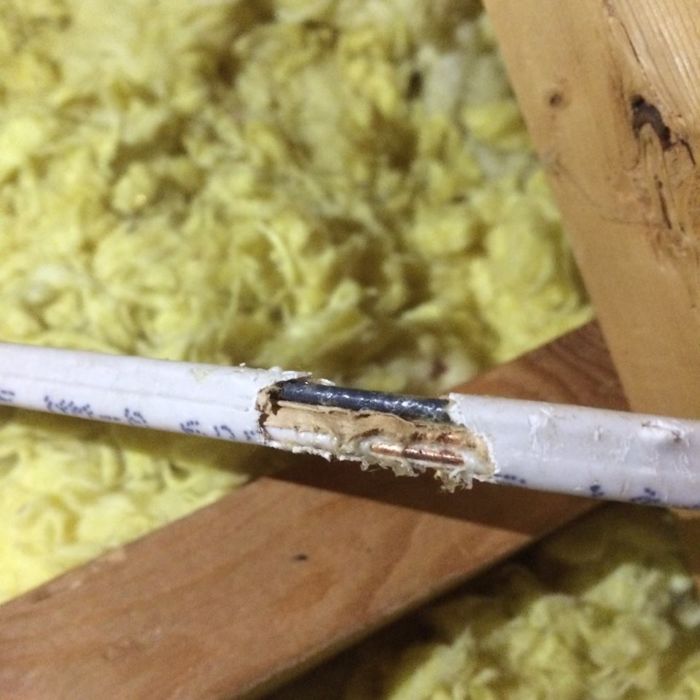Noises in the attic? Could it be squirrels or rats in attic?
I wanted to address the issue with noises in the attic, since we get these calls all the time. First of all it does not always mean that a critter actually got into your attic. But it is pretty safe to assume they are trying. It could be critters running on top of the roof and not actually inside the attic.
Some companies are known to use scare tactics to try to get you to seal your home and do a complete attic restoration just because you have heard critters in the attic or have heard scratching sounds or scurrying sounds. Here is the truth in the situation – Rodents should not be allowed to live in your attic. It can cause a tremendous amount of problems from; a build up of feces which brings odors and possible ceiling or wall staining. It can lead to chewed wires and electrical equipment.
There was a study done at a university and they found that plastic sheathing on the wires is made from a soy product and possibly attracts rats. However in another study which states “It is estimated that 25 percent of all fires attributed to “unknown causes” are probably started by rodents gnawing on gas lines, electrical wiring and matches.” Fires of unknown causes. That equates to a single digit percentage of house fires. It is not as common as you would think. Any is too much though… right! (References: http://www.idph.state.il.us/envhealth/pcmunicipal_rodents.htm & http://www.wsbtv.com/news/2-investigates/protect-your-car-rodents-eating-wires-in-newer-vehicles/242817925)
I take issue when a competitor says ” You’ve had a rodent infestation and you need to have an attic restoration.” In all of our experience we have only recommended twice (2) for a complete attic restoration. All of the others were completely fine with most having minor cleanup if a communal latrine was present.
When a wildlife company comes out to inspect they will be able to identify the exact species that has been present based upon signs, such as trails, divots, feces, prints, etc. I am always of the opinion that it is best to trap and remove & relocate the critters first. I wanted to provide you with what you should expect when hiring someone to trap: Nuisance Wildlife Trapping. Some companies go with a plan of going straight to sealing the home and using a one-way valve to get the critters out. In my humble opinion, I prefer to remove the critters that know your home as a safe place to nest and take them out of the equation. Then seal your home from future entry. Remove then seal!
Sometimes the noises heard are branches scraping the side of a house or the roof, the heating/cooling equipment in the attic or perhaps we can never explain due to lack of replication. However if you have wildlife it is inevitable that they will leave signs. Signs are sometimes discrete and only recognizable by a trained professional.
With all of this said, I want to address the DIY type people. I am all for trying to remedy a situation yourself. Oftentimes, you save money and have pride that you resolved the issue. Great! I get it. However, there is a consideration when it comes to trapping and exclusions. Exclusions is sealing a home using critter-proof material (Link explaining exclusions: Animal Proofing. Trapping, if done improperly, can educated the rodents and make it harder to trap. Sometimes – nearly impossible. Weigh out the pros and cons before you jump in to this situation and create a problem bigger than it needs to be.
all of this said, I want to address the DIY type people. I am all for trying to remedy a situation yourself. Oftentimes, you save money and have pride that you resolved the issue. Great! I get it. However, there is a consideration when it comes to trapping and exclusions. Exclusions is sealing a home using critter-proof material (Link explaining exclusions: Animal Proofing. Trapping, if done improperly, can educated the rodents and make it harder to trap. Sometimes – nearly impossible. Weigh out the pros and cons before you jump in to this situation and create a problem bigger than it needs to be.
Rodents in attics, whether it is rats in the attic or squirrels in the attic, all need to be removed. Find a Wildlife removal company that you feel comfortable working with. They should explain the process clearly and in layman’s terms and they should offer services that are humane to animals. Our State requires daily traps checks for any cage trapped animals. Even if our State & license didn’t require it we would still do it because it would be inhumane to leave animals in a cage trap for more than 24 hours without food or water. Obviously you can judge a person’s character by how they treat an animal. Once you find someone you respect & feel comfortable then move forward with a game plan.
Just remember noises in the attic doesn’t mean they are inside the attic or it is even a wildlife issue.
If you have any questions, Please reach out to me below.
Verron Federation
Licensed Wildlife Rehabber, Wildlife Trapper & Nuisance Wildlife Control Operator
Southern Wildlife Management, LLC
Facebook: http://facebook.com/southernwildlifemgmt
(678)935-5900

